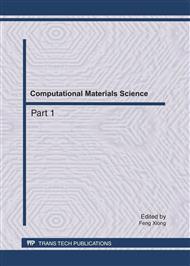p.616
p.620
p.626
p.631
p.636
p.640
p.645
p.649
p.653
Study on the Airflow Level Posture Sensor Based on Fluid-Solid Coupling
Abstract:
Using ANSYS program, the finite element simulation based on Fluid-Solid coupling is conducted by a series of procedures, such as three-dimensional model building of airflow level posture sensor according to the actual size of the proportion, network modifying, loads applying and equation solving. The flow field in three-dimensional hermetic chamber of sensitive element of airflow level posture sensor is calculated. The numerical results show that: 1) The velocity difference of air flow at two heat source changes with the tilt angle, the difference between airflow velocity increases with the increase of the tilt angle. 2)Compared with two-dimensional modeling, the simulation result of three-dimensional modeling and fluid-solid analysis methods are more comprehensive and accurate, which provides more reliable basis for practical research of the airflow level posture sensor.
Info:
Periodical:
Pages:
636-639
Citation:
Online since:
July 2011
Authors:
Price:
Сopyright:
© 2011 Trans Tech Publications Ltd. All Rights Reserved
Share:
Citation:


